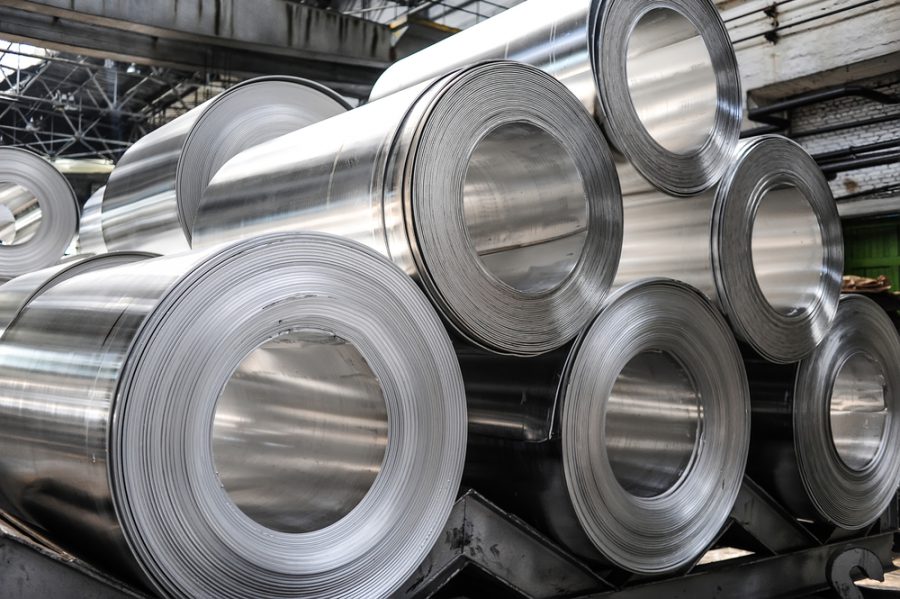
(The opinions expressed here are those of the author, Andy Home, a columnist for Reuters.)
At first glance, the tariff truce between the United States and the European Union (EU) looks like a win-win.
However, European Aluminium Association (EAA) director-general Gerd Götz called it a “lose-lose situation for the aluminum industry and their downstream customers on both sides of the Atlantic.”
The United States will exempt European steel and aluminum imports from tariffs of 25% and 10% respectively, while the EU will drop its retaliatory tariffs on US products including whiskey, powerboats, and Harley-Davidson motorcycles.
But the tariffs are replaced with quotas. This political sleight of hand effectively swaps one trade barrier for another and is unlikely to reduce the cost of aluminum for either European or US consumers.
A joint commitment to address global excess capacity by restricting higher-carbon metal lent a nice COP-26 touch to the deal but comes with a two-year timetable which may well be overtaken by aluminum’s fast-changing dynamics.
There will be no return to the way things stood before former US President Donald Trump’s administration initiated Section 232 tariffs on national security grounds in 2018.
Rather, tariffs on European imports will be replaced with tariff-free quotas based on 2018-2019 volumes, translating into 18,000 tonnes of unwrought aluminum and 366,000 tonnes of wrought products.
This complements a similar arrangement with Canada, the largest supplier of aluminum to the United States.
President Joe Biden’s administration is simply alternating between the policy options laid out in the US Commerce Department’s original Section 232 analysis.
The report suggested “specific countries” could be exempted, partially or fully, from tariffs or quotas “based on an overriding economic or security interest of the United States, which could include their willingness to … address global excess capacity and other challenges facing the U.S. aluminum industry.”
Three years later, Europe has evidently just qualified.
Remember, the objective of the Trump tariffs was to get domestic production of both steel and aluminum consistently above the 80% level. That has been largely successful in terms of the U.S. steel industry, which was operating at 84.3% of capacity in October, according to the American Iron and Steel Institute.
Things have not worked out as well for domestic primary aluminum production.
There was an initial reaction to the tariffs, US output rising from 741,000 tonnes in 2017 to 1,126,000 tonnes in 2019, but the trend turned with Alcoa’s curtailment of its Intalco smelter last year.
Domestic primary metal production fell 16% in the first nine months of 2021, with September’s annualised run-rate of 901,000 tonnes. That translates into a capacity utilization rate of just 50%, even though the price of aluminum jumped to last month’s multi-year high of $3,229 per tonne from under $2,000 per tonne in the first quarter of 2018, just before the tariffs kicked in.
The US tariffs have benefited midstream product makers at the cost of downstream manufacturers, who end up paying the full tariff-adjusted price for aluminum, even if it has come from domestic recycled sources.
European buyers are in the same boat, which is why the Federation of Aluminium Consumers in Europe greeted news of the tariff truce by pointedly calling on the EU to “accelerate the resolution of another major problem for Europe”, namely the bloc’s own 3-6% aluminum import duties.
The aluminum market, particularly at the semi-manufactured products stage, remains a highly fractured landscape of quotas, tariffs and an ever-lengthening list of countervailing and anti-dumping duties.
The deal between Europe and the United States may have only complicated the picture. Quotas “will result in even more trade distortions” and will “create additional market instability” for the value-chain, was the EAA’s warning.
What everyone agrees on is the need to restrain China’s excess capacity and exports.
Carbon will be the shield.
The arrangement with the EU would help “restrict access to our markets for dirty steel from countries like China,” President Biden told reporters.
But that may not work for aluminum. China’s aluminum producers are fully aware of the growing differentiation between low- and high-carbon aluminum.
The country’s largest private operator, Hongqiao Group, has already moved 1 million tonnes of capacity to tap the hydroelectric resources of Yunnan province, which hosts most of the country’s 4 million tonnes of aluminum capacity, powered by renewable energy. That could rise to 8 million tonnes by 2030, according to consultancy AZ China.
That’s a lot of “green” aluminum that could be sufficiently low-carbon to penetrate Europe’s or anyone else’s carbon walls.
Hongqiao has plans to shift another 2 million tonnes of production capacity to Yunnan’s green hills but they are on hold because the province is rationing power due to drought and quarterly efficiency targets.
That speaks to a bigger shift in the global aluminium landscape.
China’s own decarbonisation drive has seen multiple smelter curtailments and a near freeze on new capacity due to a lack of available power.
Right now, China lacks excess production capacity at the primary metal stage of the value-chain, and has been a consistent net importer of unwrought aluminium since the start of last year.
The excess capacity now resides exclusively in the semi-manufactured products (semis) stage and China remains a big net exporter to the tune of 4.6 million tonnes in 2020.
This imbalance between primary imports and semis exports does not look sustainable. It may be just a matter of time before Beijing starts adjusting its export tax regime to encourage more aluminum to stay at home.
What might appear good news for the rest of the world is tempered by a supply-chain crisis in silicon and magnesium, two key aluminum alloy inputs. This is due, ironically, to the energy-related closure of production plants in China.
China may not have attended the COP-26 summit but its decarbonization drive is already disrupting the aluminum landscape. By the time Europe and the United States come up with a strategy to deal with China’s excess capacity, aluminum buyers may regret its passing.
(Editing by David Gregorio)
Comments